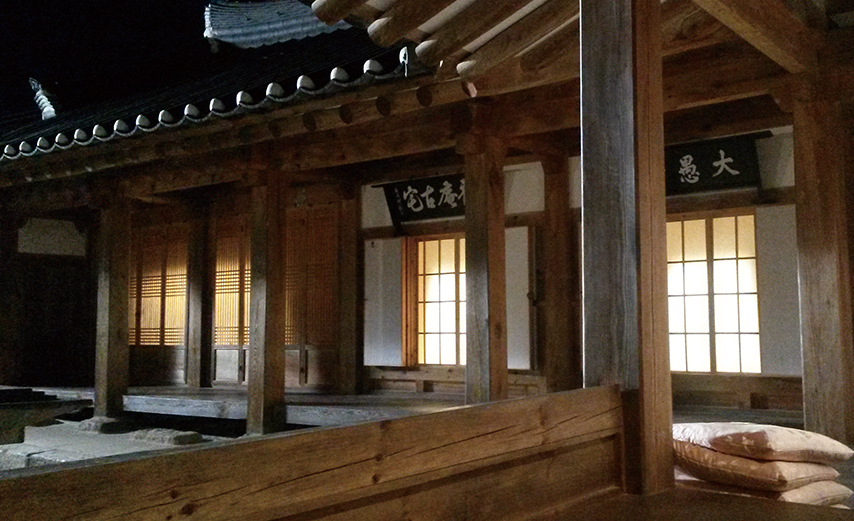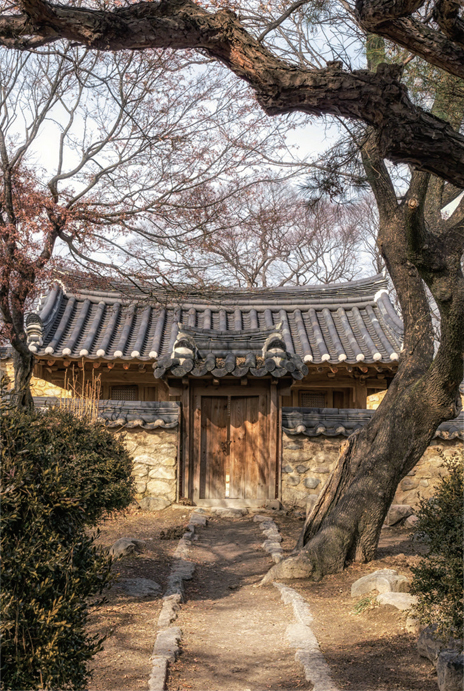
Contents





Architect Who Seeks to Transform Life






300 Years of Wealth Shared by the Choe Clan of Gyeongju
Wealth is difficult to create and even more difficult to retain. History is full of stories of descendants mismanaging and losing the wealth accrued by their ancestors. One Korean family, however, managed to keep its wealth for over 300 years dating back to the mid-Joseon era: the Choe clan of Gyeongju. Even more surprising is that the family never faced criticism or jealousy for such wealth, commanding high respect and praise from the people around them.
Written by Hwang Kyeong-soon, Researcher of National Research Institute of Cultural Heritage
 © Cultural Heritage Administration
© Cultural Heritage AdministrationThe Richest Man Feeds the Locals
The family of Choe was founded by General Choe Jin-nip, who made military contributions during the Japanese invasions in 1592 and 1597, and served in various government posts after the wars. His son Dong-nyang inherited the wealth his father received for service to his country and used it to buy a large plot of farming land. Whenever people sought to borrow plots of his land, he leased them at low rent and without going through a middleman, an uncommon practice back then. By the time his son Guk-seon took over the household, the clan was the richest in all Joseon (1392-1910), building and maintaining a reputation as a virtuous upper-class family by sharing its wealth with the poor.
The Choe clan established the foundation for its wealth management through gageo siphun (ten mottos), which emphasized the rules of conduct and economic value for their descendants. They also practiced kindness toward their neighbors through the six gahun family mottos, which stressed harmonious relations with neighbors, and yukyeon (six ways), or guidelines for individual actions in specific situations.
The first family motto was the invaluable advice “Pass the official examinations, but do not take office.” The Choe clan was thus able to avoid political entanglements by distancing themselves from power. This can be translated to the spirit of separation between political and economic power, or political neutrality in the modern day.
 Houses around Choe’s were restored to operate as Hanok (Korean traditional house) Village. © Yeungnam University Museum
Houses around Choe’s were restored to operate as Hanok (Korean traditional house) Village. © Yeungnam University MuseumAnother motto was “Do not purchase land during poor harvest years,” stressing not to exploit others’ misfortune. A poor harvest usually occurred every four years in the Joseon era, leading many small farmers to try selling their land. The Choes refused to buy such land, however, and instead provided loans of food supplies.
Another motto passed down from their ancestor, was “Do not store more than 800,000 kg of grain of wealth.” Thus, the Choe clan did not collect more than 800,000 kg (grain volume was a measurement of wealth back then) in farm rent per year, despite the full amount more than double. Because the family’s tenants paid lower rent, everyone around them hoped that the Choes would buy more land and amass even more wealth.
“Be generous to passing guests” was another Choe motto kept for generations. The family reportedly spent close to 80,000 kg in hospitality costs, indicating a remarkable number of guests at their compound. Dozens of guests stayed at the reception room each day, writing, painting and engaging in discussions. Such interaction allowed the Choes to expand their knowledge, gain valuable information and socialize in the comfort of their home.
Perhaps the most remarkable motto of the family was “Let no one starve to death within a 40 km radius.” Whenever famine struck, the clan opened up its storerooms to feed hungry neighbors. Dong-nyang, the third son of family patriarch Choe Jin-nip, would install a huge pot at a corner of the village during poor harvest years for the poor. From the generation of Choe Dong-nyang’s eldest son Guk-seon, the family spent a third of its rental income to help the needy, a truly commendable practice that continued until Choe Jun’s generation 200 years later.
 This is a picture from the childhood of the eldest grandson of the Choe family, Yeom. © Organization of Raising Choe’s Spirit
This is a picture from the childhood of the eldest grandson of the Choe family, Yeom. © Organization of Raising Choe’s SpiritThe Historic Choe Compound
The historic compound of the Choes, with walls that housed the family’s long-standing mottos, spirit of sharing and incredible wealth, is designated National Folklore Cultural Heritage No. 27, attracting numerous tourists each year and ensuring that the family’s legacy of charity and giving lives on. While the original house was in the village of Ijo-ri of Naenam-myeon (township) in Gyeongju, Gyeongsangbukdo Province, the family moved to the current site in Gyochon under Choe In-gyeong (1743-1804) and built a new compound. Since it was considered disrespectful to the ancient sages to build a private home on higher ground than hyanggyo (Confucian shrine and school), the land was lowered about 90-150 cm before construction. Servants’ quarters with lower heights were built between hyanggyo and the new house, creating a buffer ensuring that the house would not directly border the hyanggyo.
From the main gate, the order of the compound is the outer yard, servants’ yard and quarters, men’s yard and quarters, main yard and quarters, left and right auxiliary wings, and the backyard. On the western end of the main room is an ancestral shrine housing ancestral tablets and holding the top spot in the space hierarchy, followed by the main room and the guesthouse. The shrine’s location to the west of the main house is unusual since placing it to the east was typical. This placement shows deference to the ancient sages of the Confucian temple and school, as the shrine is located in close proximity to the hyanggyo.
 The light is on at a guesthouse. It was lost in 1972, and restored in 2006. © Yeungnam University Museum
The light is on at a guesthouse. It was lost in 1972, and restored in 2006. © Yeungnam University Museum The main gate of the Choe’s house. The low and moderate gate represents the family’s spirit of modesty and humbleness. © Shutterstock
The main gate of the Choe’s house. The low and moderate gate represents the family’s spirit of modesty and humbleness. © ShutterstockBuilding placement in the Choe compound shows an emphasis on Confucian values. The guesthouse was the main living quarters for men and the main house for women, and the middle gate clearly divided both spaces. The inner gates demarcated the entrance to the women’s living quarters, and entry by males who were not family members was strictly restricted. The rooms and main hall were built around the main yard, and a side door was installed to the east building, allowing access to the east storehouse.
Only remnants are left of the eightcompartment storehouse, mainly used by the main house. The facility’s estimated size based on study of the remains is rather small relative to the family’s huge fortune. This is probably due to the family’s redistribution of its autumn harvest to the needy, thus removing the need for a large storeroom.
Entrances connecting the spaces in the compound were positioned according to function and the status of the intended user. The main house had 12 large gates, and the area of the head house began from the large gate to the servants’ quarters; ordinary visitors could only go up to the guesthouse. Entry to the main house was through the front of the main yard and two inner gates. Close relatives and women used the inner gates, and the ancestral tablets were carried from the shrine to the main hall through these gates during ancestral rituals. The middle gate separated the living quarters of the men and women and the areas accessible by both genders. The corner and side doors were used by guests from the wife’s family to enter the back of the main house without going through the main yard. This system clearly designated the hierarchy and gender of people allowed to use each door, reflecting Confucian values in the compound’s layout and functions.
 The storage, once wide open to distribute grains to the needy, could accommodate 64,000 kg of rice. Only one of the storage units is left today © Yeungnam University Museum
The storage, once wide open to distribute grains to the needy, could accommodate 64,000 kg of rice. Only one of the storage units is left today © Yeungnam University MuseumContinued Contributions to Modern Korea
The Choe clan maintained its wealth for 300 years until the time of Choe Jun (1884-1970), the last descendant who lived during a time of national upheaval. During the Japanese colonial era (1910-45), he sent a million hwan (the currency of the Joseon era) to the Korean government-in-exile based in Shanghai to fund the pro-independence movement. His younger brother Wan supervised fiscal management for the provisional government but died from illness. Both brothers resolutely rejected official posts offered by Japanese officials. After Korea gained independence, the Choe family donated its entire fortune accumulated over 300 years to fund the establishment of a university. The huge wealth the clan had maintained through the modern era was thus given to society, going toward the education of future generations.
As the Biblical saying goes, it is easier for a camel to go through the eye of a needle than for a rich man to enter the kingdom of God. Sharing one’s hardearned wealth with others and giving back to society are far from easy. The Choe family, however, unselfishly shared its wealth for the greater good over generations while maintaining its assets. The clan set a truly shining example of noblesse oblige in practice. If I had to pick the setting of the most noble and beautiful story in Korean history, the Choe house in Gyeongju would be my first choice.
 The photo was taken in October of 1970. Children in the picture are in their 50s today. © Organization of Raising Choe’s Spirit
The photo was taken in October of 1970. Children in the picture are in their 50s today. © Organization of Raising Choe’s SpiritOther Articles





Architect Who Seeks to Transform Life





Application of subscription
Sign upReaders’ Comments
GoThe event winners
Go


 January 2019
January 2019


